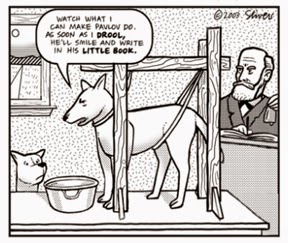As much as marketers are working to understand their customers as data points, many of them still need to understand their customers as real people. That is the fundamental challenge with big data — retaining the ability to see the unique individual within the throng of the crowd that it tends to track.
When you separate out one individual from the crowd, even as a thought exercise, it's easier to ask relevant questions. Who is this person? What do they want or need to know? How will they make their decision? What content would they be most interested in receiving? How will they use it?
With the exception of this space (which is driven by a different purpose), I ask myself these questions every day. And when the opportunity presents itself, I spend time with the people we want to reach.
People are infinitely complex and you're fooling yourself to think otherwise.
If I have learned anything in advertising and marketing over the last 25 years, it's that consumer profiling just isn't good enough. While it can be helpful in capturing a snapshot of behavior and communicating it to other marketers or executives, it tends to dismiss the complexity of people.
Understanding people with any sense of depth requires a culmination of layered analysis that considers a dozen different aspects at once. For the purposes of illustration, pretend there are three.
Personality (Core). When you work with so many diverse marketers, you become familiar with all sorts of profiling tools that are designed to better understand people. One of the most useful was considering the four personality types (or nine if you prefer) that identify common foundations people operate from.
For content creators, knowing that controllers needs to know the bottom line, analyzers want all the details, promoters are looking one step ahead, and supporters want to know how it benefits everyone else, can have a profound impact on content structure.
Learning (Input). As recently included in a guest post published by long-time friend and marketer Danny Brown, people consume information differently. In education, for example, learning styles include: visual (see), auditory (told), kinesthetic (touch), and language (read/write).
Marketers who know it are much more likely to consider a multimedia approach to their digital marketing efforts. Multimodal communication tends to resonate better and benefit from longer recall.
Behavior (Output). While not everyone appreciates it today as they did when the content was fresh, Forrester Research did an excellent job in mapping out a Social Technographics model (or what many people have come know as the social media ladder). The ladder largely breaks down participants by the activities they are most likely to engage in online.
These would include content creators, conversationalists, critics, jointers, spectators, and inactives (or passive consumers). How these different groups stack up in the data is interesting, but what is more interesting (from my perspective) is how these communication pools choose to consume, adapt, share, and build upon the content they are exposed to (if at all).
Considering such dynamic individualities makes marketing invaluable.
Creating content is one thing, but creating it (and embedding it within a content of diverse communication) so that it appeals to various personalities who consume information differently and respond to it differently is something else all together. If you want maximum attraction, retention, and action then the real challenge becomes one of content agility (covered in an upcoming post) delivered at the right time.
Naturally, this isn't exclusive to online marketing and content. Real communication is much more immersive and seeks to reach people at the right time in the right environment. And considering how challenging that can be, it only makes sense to make sure the content sent makes sense for everyone.
How about you? Do you have any layers or filters that you have found useful over the years? If you do, I would love to know. The comments are yours.





























